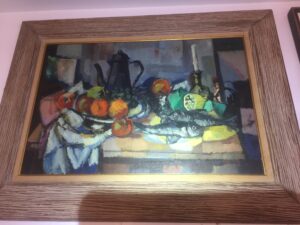 Antonio Stagnoli painted this midcentury modern piece that hung in my dining room for thirty-three years. Don’t remember where I found it, probably a thrift store. I never looked up the artist so I treated myself to research for this article.
Antonio Stagnoli painted this midcentury modern piece that hung in my dining room for thirty-three years. Don’t remember where I found it, probably a thrift store. I never looked up the artist so I treated myself to research for this article.
I found out something incredible. Born in 1922, “hearing,” Stagnoli lost that faculty at the age of two. His family, of Brescia, in Lombardy (Northern Italy), placed him in the Pio Istituto Pavoni. Founded in 1821 in a former convent, the institute educated orphans and those unable to hear or speak. MY artist, brought up in the Institute, remained there as his home for a lifetime.
A teacher noticed his talent, and sent Stagnoli to study in Milan at the Brera Academy of Art, probably in the 1930’s. An article I found mentions that Antonio Stagnoli fell in with and artistic crowd who created work in a style called New Figuration.
What does that mean?
In the time between the two World Wars, after a period dominated by abstract painting, artists rediscovered the human figure (realism). They discovered portraiture and the varieties of expression in the human face. Stagnoli, made a name for himself in one man shows in Venice, Rome, and Milan. After exhibiting throughout the 1940s through 1960s, he constantly returned to the Pio Istituto Pavoni. He died there in 2015.
A recent show in Milan featured works by artists in the style called Italian New Figuration. Italy 1920-1945: New Figuration and the Narrative Self exhibited at the La Triennale di Milano, 2017.
Antonio Stagnoli’s life gets really interesting
Kind of a recluse after his art school days, he painted places, faces, and animals around the Institute, and limited his paintings of the outside world. My painting, a still-life, he might have painted anywhere. Since I see he painted many still-lifes, I bet he painted it inside the Institute walls.
Turns out he became a bit of celebrity at the Institute and the Brescia area. A filmmaker created a short film in 2003, not so much about Stagnoli, but the artist’s experience in his visual world with sight as his superior sense. The filmmaker, Elisabetta Sgarbi, titled her film Ghosts of Voice.
Reviews of her film, around the theme of Antonio Stagnoli’s experience of art, offer insights. The film imagines the painter dreaming his life amid familiar places with the outside world an echo from a dark realm. The point of the film is that it IS a film, and film makes “visible sounds.” A painter who doesn’t hear or speak makes a perfect metaphor. The voice of the “real world” and the voice of the artist is performed on a mournful cello. One review said, “is the artist gazing upon us, or is the film gazing inward at the artist, or are we gazing upon the film? In any event, the feedback-loop analogies are hypnotic.”
Stagnoli in a Film and a Book
Istituto Pavoni of Brescia commissioned a book about former students from historian Vittorio Nichilo. The book, People of the Word, chronicles student struggles since the 18th century, fighting to achieve the fullness of life, to find all that is good, in the word.
The book offers a series of interviews with students who “speak” their lives. Stagnoli among them is mentioned as a renowned painter who came out of the Institute and made a mark on the art world.
Since Italian New Figuration is not as well-known as it SHOULD be, my painting’s kin have an auction history from $1,000 to $1,800. I now picture the artist composing the “stuff of life” on a table at the 18th century Institute’s dormitory room, and painting in silence.
I plan to print this article for my son Locky’s information. and tape an envelope containing the history on the back of the painting. Antonio Stagnoli waited thirty-three years for me to notice him, so I hope Locky finds it one day!